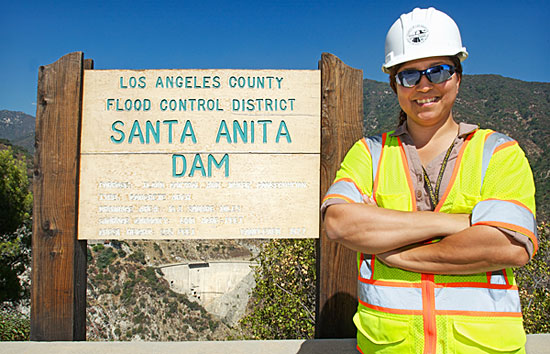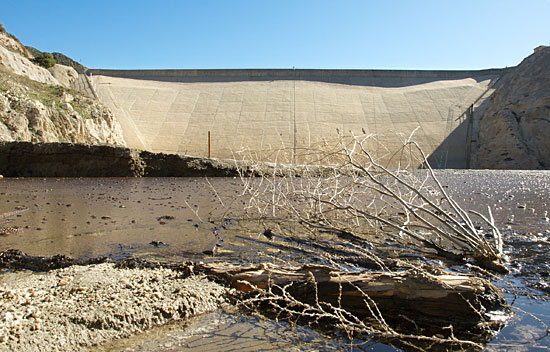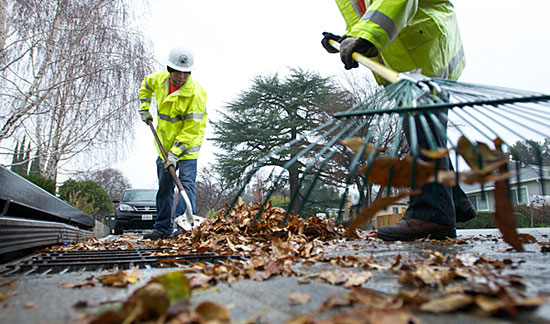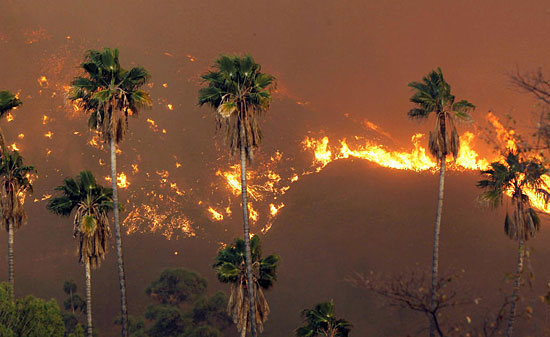Here comes the rain
February 26, 2014
The good news is that the rain has finally arrived.
Unfortunately, in some parts of Southern California, that threatens to be the bad news too.
Parched by drought and charred by wildfires, Los Angeles County has spent the week both cheering and dreading the Pacific storm systems that are predicted to soak California—and perhaps Sunday’s Academy Awards—with the wettest weather L.A. has seen since 2012.
“On one hand, the region is in sore need of drought relief, so we’re happy to have it,” says Kerjon Lee, county Department of Public Works spokesman. “But the hillsides around the Colby Fire, the Madison Fire, the Powerhouse Fire, even the Station Fire—those areas haven’t recovered.
“The hills no longer have vegetation or trees or shrubs to prevent erosion. And the upper crust of the soil has been scorched, so it’s less absorbent. Water runs across it as if it had a wax surface.”
In other words, don’t just grab an umbrella, L.A. County. Get ready for mudslides, too.
At the Department of Public Works, the situation is all-hands and the mission is twofold—first, to make sure in this drought that every possible drop of rainfall is captured, and, second, to protect local homeowners and businesses from a potential onslaught of coursing storm water and debris.
“We try not to be alarmist, but the threat right below the burn area of the Colby Fire in the foothills above Glendora is pretty serious,” Lee says.
To that end, he says, the department has been partnering not just with Glendora but with cities throughout the foothill burn areas of the San Gabriel Valley. So far, DPW engineers have advised some 700 county homeowners and businesses on ways to protect their property in the event of rain.
Public Works crews also have been working since last year with state and local agencies, the U.S. Geological Survey and others to assess risk, clean out debris basins and install crib dam structures at strategic locations in burn sites.
Drought notwithstanding, the storm preparations have been intensive. In the area of last May’s Powerhouse Fire alone, for instance, the county has installed nearly a mile’s worth of concrete barricades, or k-rail, along Walkatop, Munz Ranch, San Francisquito Canyon and Elizabeth Lake roads, plus metal standpipes at more than a dozen locations and more than 2,100 feet of embankment protection, all during the last eight months.
That’s not counting the routine storm preparations the department does every year in the county’s massive flood control system, which includes 14 major dams, 487 miles of open channels and 2,919 miles of storm drains. Or the prep work done by Los Angeles city sanitation crews, whose jobs have included clearing the catch basins near Hollywood’s Dolby Theatre, where the red carpet for Sunday’s Oscars is already out (and covered in rainproof plastic).
Nor does it include longer-term projects like La Canada’s Mullally debris basin, which was expanded in late 2010 after winter storms the prior year clogged its drainage system. (Debris from the 2009 Station Fire had been brought down by the rainstorms, and the backup had inundated nearby homeowners with a wall of mud.)
While DPW crews try to prevent storm water from inundating local roadways, county “storm boss” Michele Chimienti , who heads dam operations for the department’s water resources branch, will be trying to save as much of it as possible.
This week’s storms, heavy as they may end up being, won’t reverse the drought that has dogged California for the past three years; in fact, the overall lack of precipitation has been such a concern that this week, the Board of Supervisors extended the county’s lease on its two Super Scooper fire-fighting aircraft.
But one function of the county dams is to gather water that can be released periodically to replenish the underground aquifers that, in turn, generate about a third of the region’s drinking water.
Right now, Lee says, most of those dams are at less than 5% capacity, so there’s plenty of room for more.
While the county battens down the hatches of its infrastructure, homeowners can make their own storm preparations.
Appearing before the Board of Supervisors this week, Public Works Director Gail Farber reminded the public that the county’s Coordinated Agency Recovery Effort web site will be updated as the storm progresses with information on road conditions, flooding, forecasts, emergency contacts, disaster preparedness and assistance programs. (For details, click here.)
The Los Angeles County Sheriff’s Department suggests that, if you haven’t already, you should sign up for free public safety alerts from the department via Nixle. They also are offering tips on storm-proofing your vehicle—and your driving habits.
DPW also has this handy list of places to obtain free sandbags and this free guide to flash flood preparedness. For homeowners interested in rain barrels, the City of Los Angeles offers this guide to rainwater harvesting.
And one more bit of advice from the experts: Don’t forget to turn off your sprinklers. With any luck, the upside of this storm will carry over onto your water bill.
Posted 2/26/14
Dry time for county’s new storm boss
March 27, 2013

Meet L.A. County's storm boss, Michele Chimienti. Rainfall's been light during her first winter on the job. Photo/Public Works
If this was a normal year, water would soon be gushing from the Los Angeles County dam system’s reservoirs. It would be surging down rivers and channels, rushing into spreading grounds to be filtered and recycled, and flowing through wildlife habitats where it would sustain plants and animals through the long, hot summer.
But this is not a normal year.
For the second season in a row, winter storms have largely bypassed Los Angeles County and much of California. Local rainfall levels so far have reached only 37% of normal levels, and prospects for the kind of sustained, heavy rain required to make up the difference seem increasingly unlikely. (The storm that’s been forecast for this weekend isn’t expected to do much to bring county reservoirs—now holding just 5.5% of what they’d stockpile in a normal year—back up to where they should be.)
What’s more, a “new normal” seems to be emerging. Just ask Michele Chimienti, the county’s new “storm boss.”
“We’re seeing more of the high-highs and the low-lows. Nothing’s really normal. There’s no average,” said Chimienti, a county Public Works engineer who, since October, has been in charge of operations for the department’s water resources section. “You have one extreme or the other. Like in 2005, we had our historic wet year. That’s obviously an extreme. Then we had a dry year last year.”
For consumers, such extremes can be a pocketbook issue, with water rates going up and conservation programs aimed at lowering outdoor water use being heavily promoted—from “Cash for Grass” to “ocean-friendly” gardening.
For the water pros, the seasonal extremes are a challenge to business as usual. As hanging onto every possible drop of rainwater becomes increasingly crucial in Southern California, Public Works is accelerating its efforts to modernize and expand water retention capabilities throughout the region. (A list of completed and upcoming projects is here. Such efforts also are a central element in the proposed Clean Water, Clean Beaches parcel tax; the Los Angeles County Board of Supervisors has asked for more details on the measure before deciding whether to place it before voters next year.)
And for those like Chimienti on the frontlines of storm water management, the dry spell has posed its own kinds of challenges—of the lonely Maytag repairman variety.
“I actually would have loved it if we’d had a wet season. That’s what we thrive on,” Chimienti said. “It does get a little frustrating when we have dry year upon dry year.”
Still, she and her team are using the time in which they’d ordinarily be controlling and diverting fast-moving stormwater to make needed repairs and upgrades to the system.
“This is our downtime right now because it has been such a slow storm season,” she said, “so we’re looking toward the future: what can we do to improve our water conservation in all of our facilities?”
Even though she hit a dry patch in her first winter on the job, the 40-year-old Chimienti has seen plenty of storm activity in years gone by.
“You can volunteer for storm duty, and I did that for the past six, seven years,” she said. “It’s a good way to learn the facilities. You see the river. You see how it reacts. You get a good idea of the amounts of water, the quantity of flow that’s coming down. You get to learn the names of all the flood maintenance guys who actually do this day in and day out, run up and down the rivers, making sure people are out of the flow when water’s coming down, making sure it’s safe.”
Chimienti, the first woman to serve as the county’s “storm boss,” was named a Top Young Leader last year by the American Public Works Association, testament to her work in her previous assignment: project engineer on the $100 million Big Tujunga Dam retrofit.
The work on “Big T,” as the dam is affectionately dubbed within Public Works, focused primarily on bringing the facility up to modern seismic safety standards. But an added benefit was that a reinforced reservoir could hold—and hang onto—much more water in the wet years.
“We’re able to conserve an additional 4,500 acre feet a year,” Chimienti said. (An acre foot is approximately 326,000 gallons.)
That kind of capacity is crucial when the amounts of rainfall vary so widely from year to year. As for what’s behind the variations, Adam Walden, senior civil engineer in Public Work’s water resources division, said they might be attributable to climate change but “we don’t know for sure.”
“What is known is that, in recent years, we are seeing extremes in L.A. County’s rainfall,” according to Walden. “We have had both the wettest year on record (40.5 inches in 2004-2005 season) and the driest year on record (3.6 inches in 2006-2007 season.)”
And that, Chimienti said, means it always makes sense to conserve.
“Don’t waste it,” she said. “It is a vital natural resource, and it’s not limitless.”

Effects of dry winter are visible at county's Cogswell Dam in the San Gabriel Mountains. Photo/Public Works
Posted 3/27/13















 405 bridge work causes a stink
405 bridge work causes a stink

